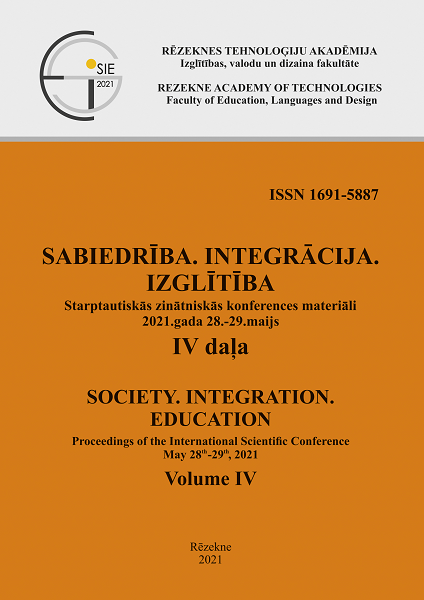PREDICTING PERFORMANCE IN SPEED CLIMBING: ACCURACY OF THE FORCE-VELOCITY TEST ON A CYCLE ERGOMETER
DOI:
https://doi.org/10.17770/sie2021vol4.6294Keywords:
best climbing time, force-velocity relationship, speed climbing, sprint cycling test, validityAbstract
The present study examined the validity of the force-velocity (F-V) mechanical parameters of the lower limbs as a predictors of the competitive performance in junior male speed climbing. The second aim was to evaluate F-V characteristics in competitive speed climbers in the junior male category. Ten junior male speed climbers (age: 18±0.5 years; BH: 174.7±4.5 cm; BW: 66.4±6.6 kg; with mean best climbing time from the competition BCT: 7.29±0.66 s) were participants in the research. All they were participants in the Youth European Cup in speed climbing. F-V characteristics were measured using a cycle ergometer test according to the Vandewalle’s protocol. To evaluate of the validity between BCT (criterion) and mechanical parameters (practical measures) from F-V test a standard error of the estimate (expressed as a raw and standardized typical error, TE) and correlation coefficients (rx,y) were used. Moreover, the validity of BCT as a potentially predictor of final competition rank (as a criterion for BCT) was evaluated. Additionally the mean value and standard deviation were calculated for all measured variables. Validity of the BCT as a competition place predictor was largely overestimated (TE=0.73 and rx,y=0.81, p p≤0.05). Accuracy of the BCT prediction for somatic and mechanical variables were very largely error biased. The standardized values of TE for these variables were: 1.93÷7.25. The rx,y were in the range of -0.18 to -0.46. The level of the mechanical variables from the F-V cycle ergometer as a predictors of the BCT in speed climbing may be largely error biased. Application of the cycle ergometer F-V test of prediction BCT values in speed climbing may have low practical value. Moreover, BCT variable may be a poor predictor of the final competition result. Coaches should take these suggestions into account during preparations to speed climbing competitions.
References
Buśko, K. (2006). Changes of force-velocity and power-velocity relationships after training performed on cycle ergometer. Biology of Sport, 23(1), 17–32.
Chelly, M. S., Chérif, N., Amar, M. Ben, Hermassi, S., Fathloun, M., Bouhlel, E., Tabka, Z., & Shephard, R. J. (2010). Relationships of Peak Leg Power, 1 Maximal Repetition Half Back Squat, and Leg Muscle Volume to 5-m Sprint Performance of Junior Soccer Players. Journal of Strength and Conditioning Research, 24(1), 266–271. https://doi.org/10.1519/JSC.0b013e3181c3b298
Hopkins, W. (2015). Spreadsheets for analysis of validity and reliability. Sportscience, 19, 36–42.
Krawczyk, M., Ozimek, M., Pociecha, M., Draga, P., Zadarko, E., & Barabasz, Z. (2020). Selected morphofunctional characteristics and their correlations with performance of female and male speed climbers. Science & Sports. https://doi.org/10.1016/j.scispo.2019.11.009
Krawczyk, M., Ozimek, M., Rokowski, R., Pociecha, M., & Draga, P. (2018). Anthropometric characteristics and anaerobic power of lower limbs and their raltionships with race time in female climbers. SOCIETY. INTEGRATION. EDUCATION Proceedings of the International Scientific Conference., IV, 118–126. https://doi.org/10.17770/sie2018vol1.3268
Krawczyk, M., Pociecha, M., Ozimek, M., & Draga, P. (2020). The force, velocity, and power of lower limbs as a determinants of speed climbing efficiency. Trends in Sport Sciences, 27(4), 219–224. https://doi.org/10.23829/TSS.2020.27.4-5
Krawczyk, M, Ozimek, M., Pociecha, M., Draga, P., Zadarko, E., & Barabasz, Z. (2020). Selected morphofunctional characteristics and their correlations with performance of female and male speed climbers. Science & Sports, 35(4), 243–245. https://doi.org/10.1016/j.scispo.2019.11.009
Krawczyk, M, Ozimek, M., Pociecha, M., & Gabryś, T. (2019). Morfofunkcjonalne uwarunkowania wyników sportowych we wspinaczce na czas i boulderingu. Wydawnictwa Państwowej Wyższej Szkoły Zawodowej w Tarnowie.
Krawczyk, M, Pociecha, M., Kozioł, P., Stepek, A., Guzy, R., Więcek, K., & Rzepa, K. (2019). Morphological features and the strength-speed fitness of female volleyballers at a high sports level. Health Promotion & Physical Activity, 8(3), 6–11. https://doi.org/10.5604/01.3001.0013.4330
Krawczyk, M, Pociecha, M., Ozimek, M., Stepek, A., & Kozioł, P. (2020). Value of speed capabilities in youth speed climbing at high sports level. SOCIETY. INTEGRATION. EDUCATION. Proceedings of the International Scientific Conference, 6, 264. https://doi.org/10.17770/sie2020vol6.4862
Legreneur, P., Quaine, F., Chapelle, S., & Reveret, L. (2018). Interpretation of hip mechanical energy in official speed climbing route. 4th IRCRA International Congress.
Legreneur, P., Rogowski, I., & Durif, T. (2019). Kinematic analysis of the speed climbing event at the 2018 Youth Olympic Games. Computer Methods in Biomechanics and Biomedical Engineering, 22(sup1), S264–S266. https://doi.org/10.1080/10255842.2020.1714907
Levernier, G., Samozino, P., & Laffaye, G. (2020). Force–Velocity–Power Profile in High-Elite Boulder, Lead, and Speed Climber Competitors. International Journal of Sports Physiology and Performance, 15(7), 1012–1018. https://doi.org/10.1123/ijspp.2019-0437
Martin, R. J. F., Dore, E., Hautier, C. A., Van Praagh, E., & Bedu, M. (2003). Short-Term Peak Power Changes in Adolescents of Similar Anthropometric Characteristics. Medicine & Science in Sports & Exercise, 35(8), 1436–1440. https://doi.org/10.1249/01.MSS.0000079074.47756.AB
Nebil, G., Zouhair, F., Hatem, B., Hamza, M., Zouhair, T., Roy, S., & Ezdine, B. (2014). Effect of optimal cycling repeated-sprint combined with classical training on peak leg power in female soccer players. Isokinetics and Exercise Science, 22(1), 69–76. https://doi.org/10.3233/IES-130515
Nikolaidis, P. T. (2012). Age-related differences in force-velocity characteristics in youth soccer. Kinesiology, 44(2), 130–138.
Shunko, A., & Kravchuk, T. (2020). Competitive modelling in speed climbing. BIO Web of Conferences, 26, 00051. https://doi.org/10.1051/bioconf/20202600051
Vandewalle, H., Peres, G., Heller, J., Panel, J., & Monod, H. (1987). Force-velocity relationship and maximal power on a cycle ergometer. Correlation with the height of a vertical jump. European Journal of Applied Physiology and Occupational Physiology, 56(6), 650–656.






